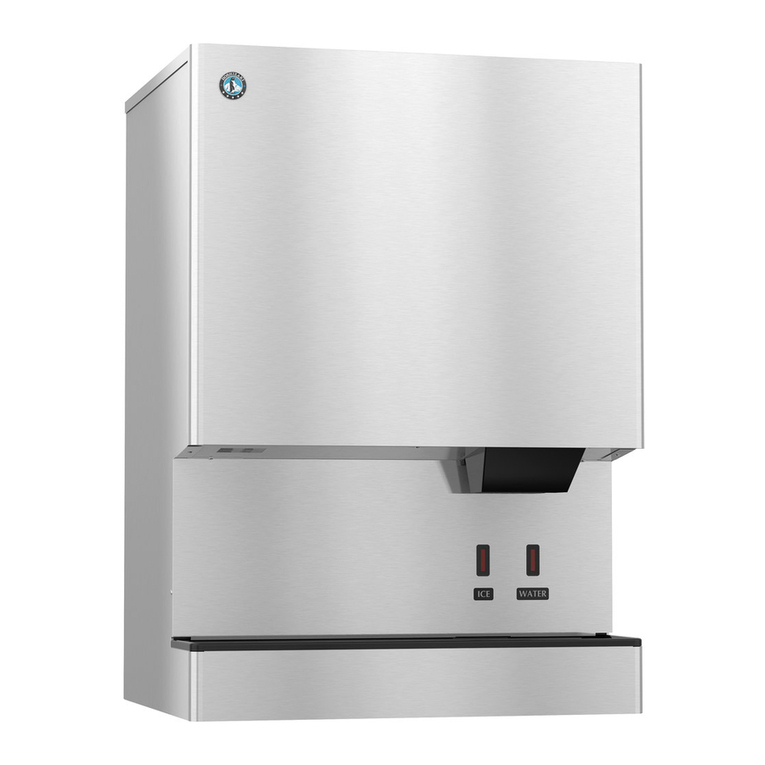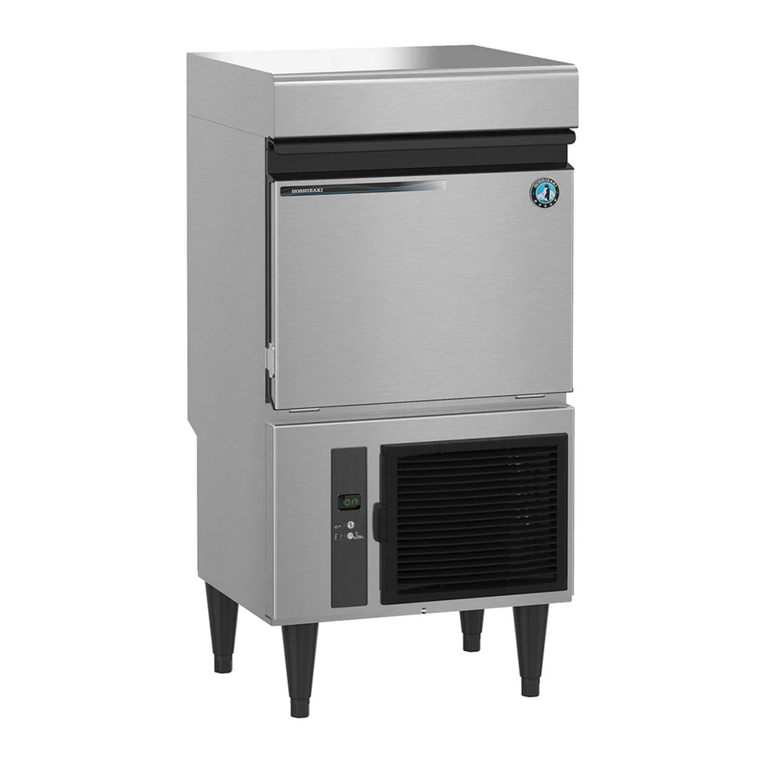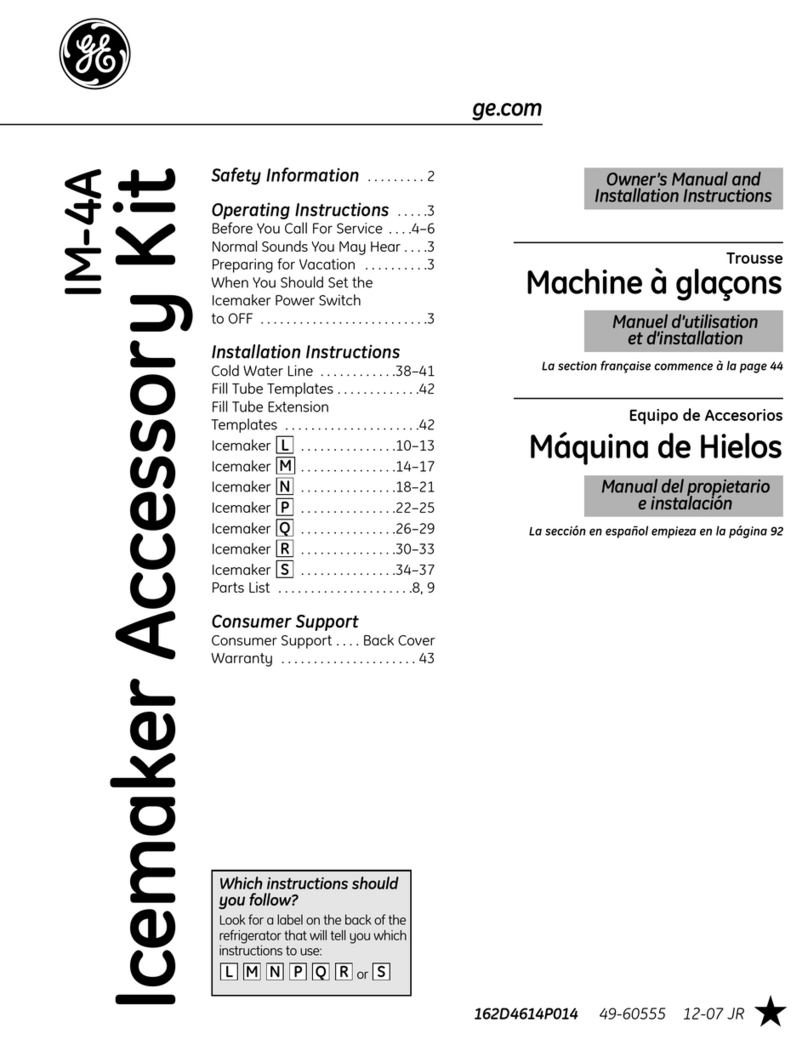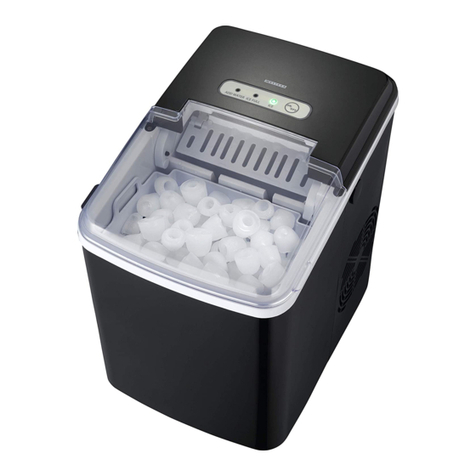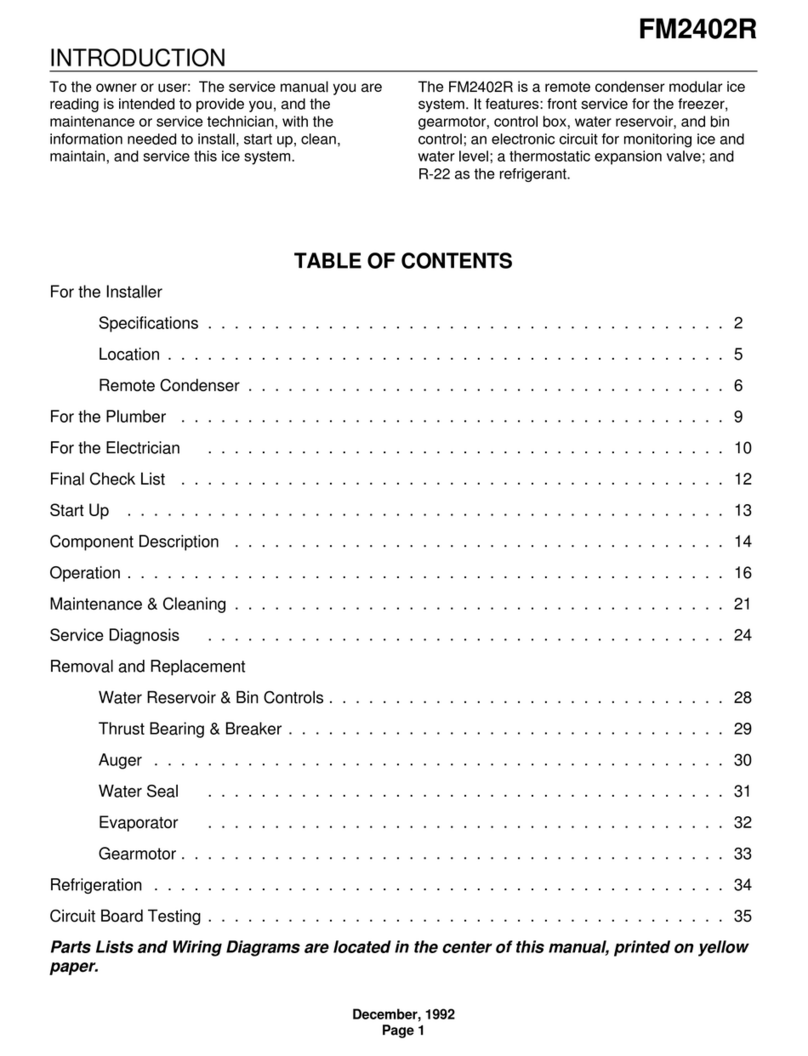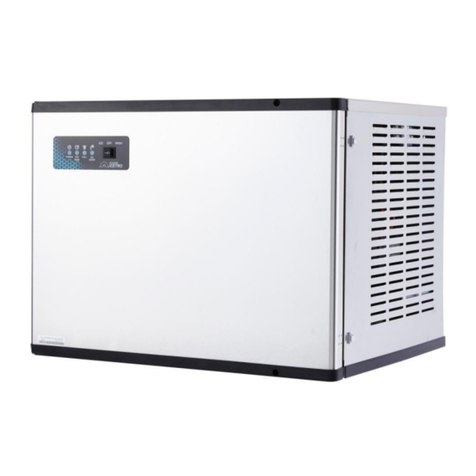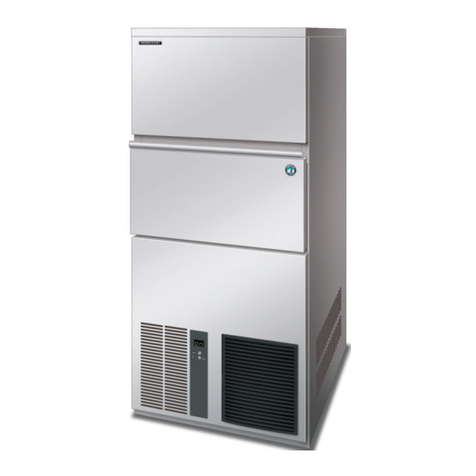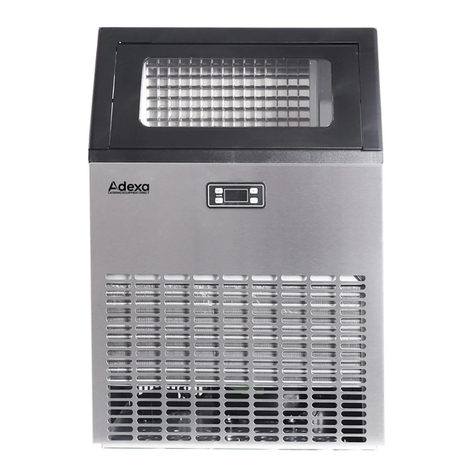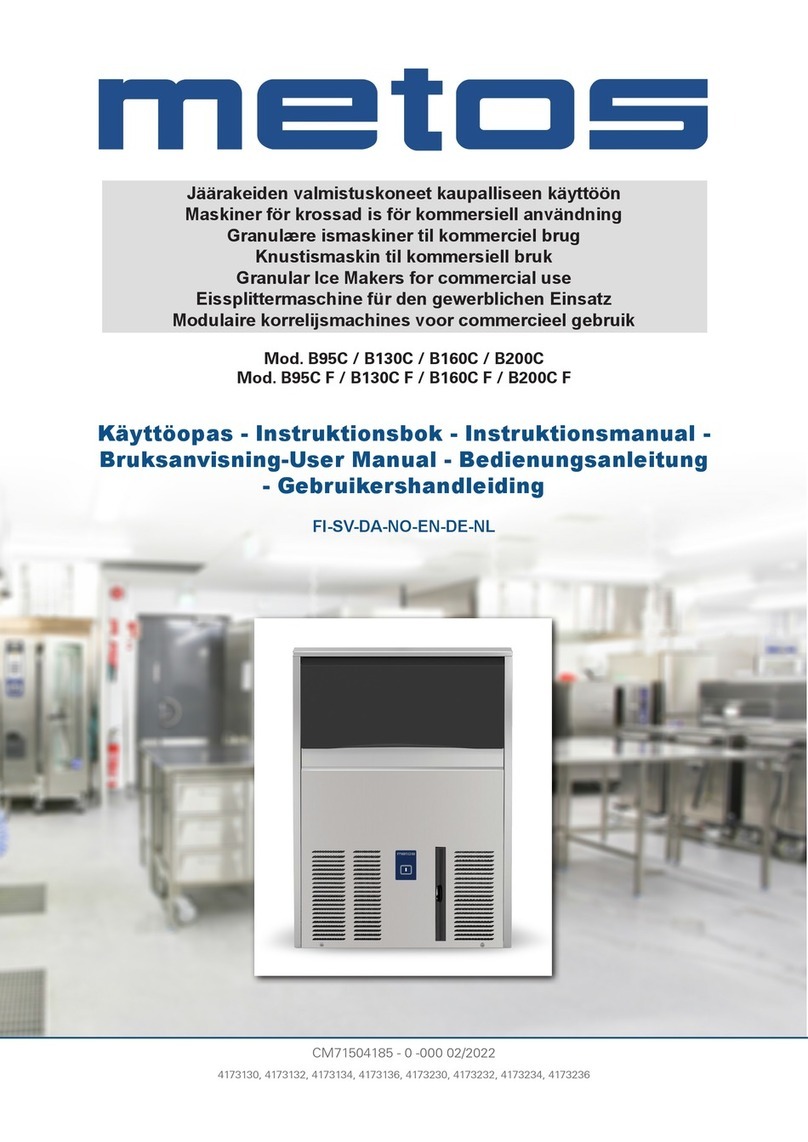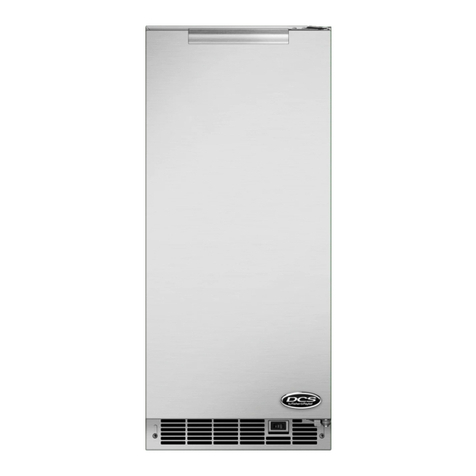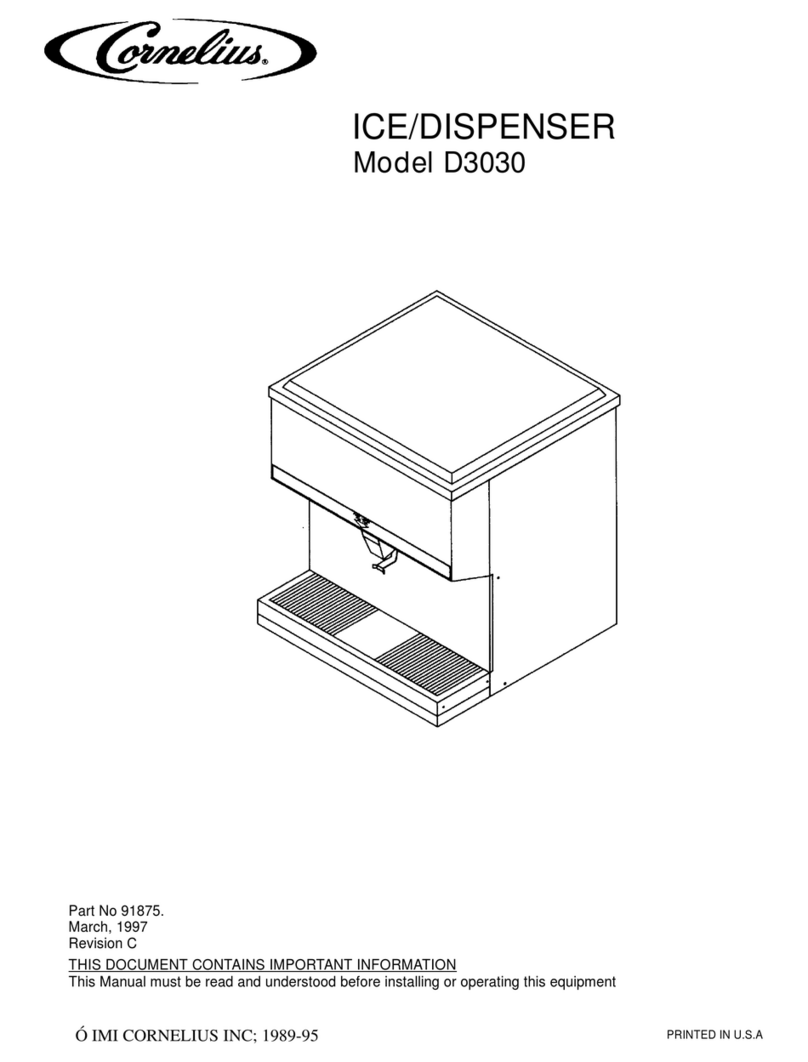THOR TIM1501 User manual

FEATURES & BENEFITS
15 INCH ICE MAKER TIM1501
TECHNICAL DETAILS
Appliance Type Compressor
Color/Finish Stainless Steel
Ice Production Per Day 50 lb.
Ice Storage Capacity 25 lb.
Cube 0.75 cu. in.
Noise Rating 55 dB
WARRANTY: TWO YEAR PARTS AND LABOR
Product: 15 Inch Built-In Ice Maker in Stainless Steel
Model Number: TIM1501
INCLUDED ACCESSORIES
Ice Scoop Included
Built-in Pump
Built-in pump increases potential installation locations and makes
install a breeze.
Steady Production
Makes up to 50 lb. of ice cubes every 24 hours for a steady supply of ice.
Ample Storage
Large-capacity bin stores up to 25 lbs. of cube-shaped ice.
LED Lighting
Striking blue LED interior light.
Automatic Shut-Off
Automatic shut-off when the ice bin is full prevents overflow.
Multiple Design Options
Built-in or freestanding design for a variety of installation options.
Automatic Defrost
Low maintenance operation with automatic defrost.
Ice Scoop Included
Includes ice scoop for easy removal of ice.
Stainless-steel Design
Stainless steel door with pro handle offers a professional look for
any location.
Energy Star Certified
Energy Star and UL certified.

15 INCH ICE MAKER TIM1501
PRODUCT DIMENSIONS
Product Width 14 9/16”
Product Depth 23 5/16”
Product Depth with Handles 25”
Product Height 32 11/16”
Cut-Out Left to Right Width min. 15 1/8”
Cut-Out Front to Back Depth min. 25”
Cut-Out Height min. 33”
PRODUCT WEIGHT
Gross Weight 85.98 lb.
Net Weight 94.8 lb.

USE AND CARE MANUAL
COOK
LIKE
A
GOD
15 INCH BUILT-IN ICE MAKER TIM1501

15 INCH BUILT-IN
ICE MAKER
USE AND CARE MANUAL
TIM1501

Page
We reserve the right to make changes in specifications and design without prior notice.
TABLE OF CONTENTS
01
ICE MAKER SAFETY············································································ 2
IMPORTANT SAFEGUARDS······························································ 3 - 5
TECHNICAL INFORMATION······································································5
COMPONENT LOCATIONS·······································································6
ICE MAKER INSTALLATION································································7 - 14
Unpacking·························································································· 7
Location requirements ········································································8-9
Electrical requirements ········································································10
Leveling the ice maker·········································································11
Reversing the door swing ·······························································11 - 12
Water supply················································································12 - 13
Drain··························································································13 - 14
Installation types·················································································15
OPERATION····················································································16 - 20
Final check list before operation·····························································16
Operating method·········································································16 - 17
How the machine makes ice··································································17
How the machine uses the water····························································18
How the pump out water drain system operates·································· 18 – 19
Normal sounds···················································································20
Preparing the ice maker for long storage··················································20
CLEANINGAND MAINTENANCE·····················································21 - 25
Exterior cleaning·················································································21
Interior cleaning··················································································22
Condenser cleaning·············································································22
Water distribution tube cleaning······························································23
Ice-making system cleaning ····························································23 - 24
Control Panel·····················································································25
Ice Size Adjustment Guide······························································24 - 26
MAJOR FUNCTIONS···········································································26
TROUBLESHOOTING ·································································· 27 – 28
WARRANYY··············································································· 29 – 31

ICE MAKER SAFETY
Your safety and the safety of others are very important.
We have provided many important safety messages in this manual and on your
appliance. Always read and obey all safety messages.
This is the Safety Alert Symbol. This symbol alerts you
to potential hazards that can injure or kill you and others.
All safety messages will follow the Safety Alert Symbol and
either the words "DANGER", "WARNING" OR
"CAUTION".
DANGER means that failure to heed
this safety statement may result
in severe personal injury or death.
WARNING means that failure to heed
this safety statement may result in
extensive product damage, serious
personal injury or death.
CAUTION means that failure to heed
this safety statement may result in
minor or moderate personal injury,
or property or equipment damage.
All safety messages will alert you to what the potential hazard is, tell you how to
reduce the chance of injury, and let you know what can happen if the instructions are
not followed.
IMPORTANT SAFETY INSTRUCTIONS
WARNING: To reduce the risk of fire, electric shock or injury when using
your ice maker, follows these basic precautions:
·Plug into grounded 3-prong outlet.
·Do not remove grounding prong.
·Do not use an adapter.
·Do not use an extension cord.
·Disconnect power before cleaning.
·Disconnect power before servicing.
·Replace all panels before operating.
·Use two or more people to move & install ice maker.
SAVE THESE INSTRUCTIONS
DANGER
WARNING
CAUTION
02

IMPORTANT SAFEGUARDS
Before the ice maker is used, it must be properly positioned and
installed as described in this manual, so read the manual
carefully. We strongly recommend that you have a professional
install your new machine. The warranty may be affected or voided by an
incorrect installation. To reduce the risk of fire, electrical shock or injury
when using the ice maker, follow basic precautions, including the following:
•Plug into a grounded 3-prong outlet; do not remove grounding prong, do not use
an adapter, and do not use an extension cord.
•It is recommended that a separate circuit, serving only your ice maker, be
provided. Use receptacles that cannot be turned off by a switch or pull chain.
•Do not connect or disconnect the electric plug when your hands are wet.
•Never unplug the ice maker by pulling on the power cord. Always grip the plug
firmly and pull straight out from the outlet.
•Never clean ice maker parts with flammable fluids. Do not store or use gasoline
or other flammable vapors and liquids in the vicinity of this or any other
appliances. The fumes can create a fire hazard or explosion.
•Before proceeding with cleaning and maintenance operations, make sure the
power line of the unit is disconnected and the water line is shut off.
•Before operating, pull all panels back into place.
•Never allow children to operate, play with or crawl inside the ice maker.
•Do not touch the evaporator with your hand when the machine is operating.
•Unplug the ice maker or disconnect power before cleaning or servicing. Failure
to do so can result in electrical shock or death.
•Do not attempt to repair or replace any part of your ice maker unless it is
specifically recommended in this manual. All other servicing should be referred
to a qualified technician.
•Use two or more people to move and install the ice maker. Failure to do so can
result in back or other injury.
•To ensure proper ventilation for your ice maker, the front of the unit must be
completely unobstructed. Choose a well-ventilated area with temperatures
above 45°F (7°C) and below 110°F (43°C).
•The ice maker should not be located next to ovens, grills or other sources of
high heat.
•The ice maker must be installed with all electrical and water connections in
accordance with state and local codes. A standard electrical supply (115 V AC,
60 Hz, 15 A), properly grounded in accordance with the National Electrical Code
and local codes and ordinances, is required.
•Do not kink or pinch the power supply cord between the ice maker and cabinet.
DANGER
WARNING
03

•The fuse (or circuit breaker) size should be 15 amperes.
•It is important for the ice maker to be leveled in order to work properly. Otherwise
water may not flow properly through the evaporator (ice mold). The ice production will
be less than normal. You may need to make several adjustments to level it.
•All installations must be in accordance with local plumbing code requirements.
•Make certain that hoses are not pinched, kinked or damaged during installation.
•Check for leaks after water line is connected.
•Although the unit has been tested and cleaned at the factory, due to long-term transit
and storage, the first batch of cubes must be discarded.
•Remove the packing materials and clean the ice maker before using.
•Turn on the water supply tap before switching on the ice maker. Never turn the water
supply tap off when the ice maker is working.
•Except to take ice from the unit, keep the door closed in order to reduce ice melting
and to promote proper ice formation.
•If the ice maker will not be used for a long time, before the next use it must be
thoroughly cleaned. Follow carefully any instructions provided for cleaning or use of
sanitizing solution. Do not leave any solution inside the ice maker after cleaning.
•DO NOT use solvent-based cleaning agents or abrasives on the interior. These
cleaners may transmit taste to the ice cubes, or damage or discolor the interior.
•The ice machine cleaner contains acids. Do not use or mix with any other solvent-
based cleaning products. Use rubber gloves to protect hands. Carefully read the
safety instructions on the container of the ice machine cleaner.
•Do not use the apparatus other than for its intended purpose.
04
SAVE THESE INSTRUCTIONS
Electrical Connection
Do not, under any circumstances, cut or remove the third (ground) prong from the
power cord. For personal safety, this appliance must be properly grounded. The
power cord of this appliance is equipped with a 3-prong grounding plug that
mates with a standard 3-prong grounding wall outlet to minimize the possibility of
electric shock hazard from the appliance. Have the wall outlet and circuit checked by
a qualified electrician to make sure the outlet is properly grounded. When a standard
2-prong wall outlet is encountered, it is your responsibility and obligation to have it
replaced with a properly grounded 3-prong wall outlet. The ice maker should
always be plugged into its own individual electrical outlet which has a voltage rating
that matches the rating label on the appliance. This provides the best performance
and also prevents overloading house wiring circuits which could cause a fire hazard
from overheated wires. Never unplug your ice maker by pulling on the power cord.
Always grip the plug firmly and pull straight out from the outlet. Repair or replace
immediately all power cords that have become frayed or otherwise damaged. Do
not use a cord that shows cracks or abrasion damage along its length or at either
end. When moving the ice maker, be careful not to damage the power cord.
Extension Cord
Because of potential safety hazards under certain conditions, it is strongly
recommended
that you do not use an extension cord with this ice maker.

TECHNICAL INFORMATION
Model: TIM1501
Electrical power: 115VAC ~ 60Hz
Power consumption: 9.71 kWh/100 lbs of ice
Ice-making /-harvest rated current: 3.0A/4.0A
Refrigerant: R134a, 3.88 oz
High/Low side pressure: 350 psig/130 psig
Width x depth x height: 14.6" x 23.6" x 32.6"
Unit weight: 84 lbs
Maximum ice storage: 25 lbs
Ice-making capacity: 50 lbs/day*
Ice shape: Cube
Ice cube dimensions: 7/8″ x 7/8″ x 7/8″
The technical data and performance index listed above should be used for
reference only. They are subject to change.
*The actual quantity of ice produced per day can vary with environment and
water conditions.
05

Water distribution tube
Evaporator (ice mold)
Water trough
Float
Ice storage bin
Control panel
Front louver panel Flat feet
Door
COMPONENT LOCATIONS
Ice scoop
Water supply hose
Power cord
Water inlet
Drain outlet
Drain hose
06

ICE MAKER INSTALLATION
Unpacking
Remove packaging materials.
IMPORTANT: Do not remove any permanent instruction labels or the data
label on your ice maker.
Remove tape and glue from your ice maker before using.
•To remove any remaining tape or glue, rub the area briskly with your thumb.
Tape or glue residue can also be easily removed by rubbing a small amount of
liquid dish soap over the adhesive with your fingers. Wipe with warm water and
dry.
•Do not use sharp instruments, rubbing alcohol, flammable fluids, or abrasive
cleaners to remove tape or glue. These products can damage the surface of
your ice maker.
Cleaning before use
After you remove all of the packaging materials, clean the inside of your ice
maker before using it. See the "Interior cleaning" in the Cleaning and
Maintenance section.
Excessive Weight Hazard
Use two or more people to move and install ice
maker. Failure to do so can result in back or other
injury.
WARNING
07

Product Description
Model No.
Width Height Depth
14.6" 32.6" 23.6"
Install the Indoor Automatic Ice Maker
Your product has been designed built-in or free standing
installation Cutout Dimensions
Dimensions of the recess
Width of housing 15.1" 383.7mm
Height of housing 32.9" 835.6mm
Depth of housing 25.6"650.8mm
Unit
Dimensions
(inches)
Automatic Ice Maker
TIM1501
Min 25.6"(650.8mm)
Min 15.1"(383.7mm)
Min 32.9"(835.6mm)
23.6"(600mm)
14.6"(371mm)
32.6"(827mm)
Specifications-Model#TIM1501
When installing the ice maker under a counter, follow the recommended
spacing dimensions shown. Allow at least 2" (50.8 mm) of clearance at rear,
and ¼" (6.35mm)at sides for proper air circulation.
The installation should allow the ice maker to be pulled forward for servicing if
necessary.
08
LOCATION REQUIREMENTS

•This ice maker should be properly installed by qualified personnel.
•To ensure proper ventilation for your ice maker, the front of the unit
must be completely unobstructed.
•Choose a well ventilated area with temperatures above 45°F (7°C) and
below 110°F (43°C).
•The unit should not be located next to ovens, grills or other high heat sources.
•Installation of the ice maker requires a cold water supply inlet of ¼-in.
(6.35mm) soft copper tubing with a shut-off valve.
•The ice maker requires a continuous water supply with a minimum pressure of
15 psig and a static pressure not to exceed 80 psig. The temperature of the
water feeding into the ice maker should be between 41°F (5°C) and 90°F (32°
C) for proper operation.
•It is strongly recommended that a water filter be used. A filter, if it is
of the proper type, can remove taste and odors as well as particles. Some
water is very hard, and softened water may result in white, mushy cubes
that stick together. Deionized water is not recommended.
•The ice maker must be installed with electrical and water connections in
accordance with all state and local codes.
•The unit should be located on a firm and level surface. It is important for the ice
maker to be leveled in order to work properly. If needed, you can adjust the
height of the ice maker by revolving the caster. See the Leveling the Ice Maker
section.
•A standard electrical supply (115V AC only, 60Hz, 15A), properly
grounded in accordance with the National Electrical Code and local
codes and ordinances, is required.
IMPORTANT: Do not kink or pinch the power supply cord between the icemaker
and wall or cabinet.
Normal operating ambient temperature should be between 45°F (7°C)
to 110°F (43°C). Normal operating water temperature should be
between 41°F (5°C) and 90°F (32°C). Operation of the ice maker for
extended periods outside of these normal temperature ranges may
affect production capacity.
WARNING
09

Electrical requirements
Before you move your ice maker into its final location, it is important to make
sure you have the proper electrical connection:
A standard electrical supply (115V AC only, 60Hz, 15A), properly grounded in
accordance with the National Electrical Code and local codes and ordinances,
is required. The ice maker should always be plugged into its own individual
electrical outlet.
It is recommended that a separate circuit, serving only your ice maker, be
provided. Use a receptacle that cannot be turned off by a switch or pull chain.
The fuse (or circuit breaker) size should be 15 amperes.
Recommended grounding method
For your personal safety, this appliance must be grounded. This appliance is
equipped with a power supply cord having a 3-prong grounding plug. To minimize
possible shock hazard, the cord must be plugged into a mating 3-pronged and
grounding-type wall receptacle, grounded in accordance with the National
Electrical Code and local codes and ordinances. If a mating wall receptacle is not
available, it is the personal responsibility of the customer to have a properly
grounded, 3-prong wall receptacle installed by a qualified electrician.
Electrical Shock Hazard
Plug into a grounded 3-prong outlet.
Never remove the ground prong from the plug.
Never use an adapter.
Never use an extension cord.
Failure to follow these instructions can result in fire,
electrical shock or death.
DANGER
10

Leveling the ice maker
It is important for the ice maker to be leveled in order to
work properly. Otherwise water will not flow properly
through the evaporator (ice mold). The
ice production will be less than normal, and may
be noisy. The unit can be raised or lowered by rotating
the plastic sheaths around each of the four rolling
casters on the bottom of the machine. If you
find that the surface is not level, rotate the casters until
the ice maker becomes level. You may need
to make several adjustments to level it. We
recommend using a carpenter’s level to check
the machine.
1. Place a carpenter’s level on top of the unit to see if the ice maker is level from
front to back and side to side.
2. Adjust the height of the casters as follows:
Turn the leveling casters to the right to lower that side of the ice maker.
Turn the leveling casters to the left to raise that side of the ice maker.
You will find that the casters make it easy for one person to move the
machine. This is useful for cleaning and sanitizing the surface on which the ice
maker is installed because it allows you to move the unit and have easy access to
the surface to be cleaned. IMPORTANT: When the ice maker is ready to be
installed in a cabinet or directly on the floor, you must adjust the feet to level
the ice maker and lock the rollers. If the floor is level, just revolve the two front
feet to touch the floor.
Reversing the door swing
Tools needed: flathead screwdriver, Phillips screwdriver
IMPORTANT: Before you begin, unplug the ice maker or disconnect power.
To remove door from hinges:
1. Using a flathead screwdriver, seperate the axis from the hinge 1. Set aside.
2. Open the door about 20°around the bottom hinge 2 axis, then lift the door
off the bottom hinge 2 and set door aside.
3. Using a flat screwdriver, remove the two plug buttons from the screw holes
on the door. Set aside.
4. Using a Phillips screwdriver, remove the magnet baffle, then place them
on the opposite side at the top of the door.
5. Push the two plug buttons into the spare screw holes.
down
up
11

To replace door on hinges:
1. Using a flathead screwdriver, remove the plug buttons from the screw holes
opposite the door hinges, top and bottom. Set aside.
2. Replace the axis on the door hinge 1 and tighten it firmly. Remove the door
hinge 1 and place it on the opposite bottom side.
3. Remove the door hinge 2 and place it on the opposite top side. Separate the
axis from the hinge 2 and set it aside.
4. Keep the handle apart from the hinge side. Allign the door on the bottom
hinge 1 and replace axis on the hinge 2. Tighten it firmly.
5. Push the plug buttons into the original screw holes.
See Figure below.
Water Supply
The water supply should be ready at the point of installation. The water supply
pressure should be a minimum of 15 psig with a static pressure not more than
80 psig. (A wall outlet directly behind the ice machine will make installation
easier.)
IMPORTANT:
1. All installations must be in accordance with local plumbing code
requirements. Professional installation is recommended.
2. Make certain the hoses are not pinched or kinked or damaged during
installation.
3. Check for leaks after connection.
Tools required:
½-in. open-end wrench, Phillips
screwdriver
12

Connecting the water line:
1. Turn off main water supply. Turn on the nearest faucet long enough to clear
line of water.
2. Find a ½-in. to ¾-in. vertical cold water pipe near the installation
location. The distance should be less than 6 feet. The water supply hose
provided with the ice maker is about 6 feet long.
3. A shut-off valve must be installed to the main water supply. If the water pipe
has a plain piece of copper tubing, attach a ¼” O.D. compression union to
the tubing and remove the nut.
4. Connect the nut of the water supply hose to the tap, and connect the other end
with the water inlet. Tighten firmly by hand, then one-half turn with wrench.
5. Turn on main water supply and tap. Check for water supply connection leaks.
Tighten every connection (including connection at the water inlet).
IMPORTANT: When you connect the water supply hose and the drain hose, pay
attention to the indications of “Water inlet” and “Drain outlet” on the machine.
Drain
You must connect the drain line before using the ice maker. Follow the steps
outlined below.
There are two types of ice machine modes, one that drains by gravity and one
that has an internal drain pump.
This unit can pump out water up to a rise of 1.5m (59”) or over a horizontal length
of 1.5m (59”).
WATER VALVE
WATER FLTER
POWER
WATER INLET
WATER DRAIN
13

Connecting the drain line:
NOTE: If there is a drain line near the ice maker, the best choice is to drain
water to the drain line through the drain water hose provided with ice maker.
1. Locate the floor drain near the ice maker. The distance should be less than 5
feet since the length of the long drain water hose provided with the ice maker is
about 5 feet.
2. Find the drain outlet on the back of ice maker. Connect the drain outlet to
the water draining hose, and insert the other end of the hose into the drain line.
3. All horizontal runs of drain lines must have a fall of ¼” per foot. An air gap will
likely be required between the ice maker drain tube and the drain/waste
receptacle. A standpipe with a trap below it would be acceptable for the
drain/waste receptacle. A floor drain is also acceptable. If this is not possible,
the use of a condensate pump is recommended.
4. Pour 1 gallon of water into the ice storage bin to check for leaks in the drainage
system. Tighten any connections that leak.
IMPORTANT: This ice maker is not a freezer. Infrequent drainage will
cause a high rate of melting in the ice storage bin.
WATER VALVE
WATER FLTER
POWER
WATER INLET
WATER DRAIN
14

Installation Types
This ice maker has been designed for Mobile (free-standing) installation.
However, it can also be Enclosed (as under a cabinet) or Built-in (sealed to the
floor). In any case, there must be adequate air space around the unit for
ventilation.
Mobile installation:
A mobile installation will allow you to install the ice maker free-standing in any
place you desire provided you have access to a water supply. You must follow the
stated instructions for
a. Electrical
requirements
b. Water supply
c. Leveling the ice
maker.
Enclosed Installation:
An enclosed installation will allow you to install the ice maker under a cabinet
or in a kitchen cabinet provided the required clearance space around the ice
maker is respected. This installation has the same requirements as a mobile
installation.
Built-in installation:
If this method of installation is chosen, it will still be necessary to allow
adequate ventilation space around the unit. The following additional items must
be observed.
1. Place ice maker in front of installation location. Remove the feet and place the
unit flat on the floor or on a platform depending on your installation
requirements.
2. The water supply line must be plumbed before connecting to the ice maker.
3. Turn on main water supply and tap. Check for water supply connection leaks.
Tighten every connection (including connection at the water inlet).
4. If the electrical outlet for the ice maker is behind the cabinet, plug in the ice
maker.
5. Push the ice maker into position.
6. Seal all around the cabinet to the floor with an approved caulking compound.
IMPORTANT: Be sure the drain hose is connected and fed into the drain
line before the ice maker is moved into its final position.
15

OPERATION
Final Check List before Operation
1. Have all packing materials and tape been removed from the interior and
exterior of the ice maker?
2. Did you clean the ice storage bin?
3. Have the installation instructions been followed, including connecting the
machine to water and electricity?
4. Has the machine been leveled?
5. Is the ice maker in a site where the ambient temperature is between 45°F
(7°C) and 110°F (43°C) and the water temperature between 41°F (5°C) and
90°F (32°C) all year- round?
6. Has the water supply pressure been checked to ensure a minimum of 15
psig with a static pressure not to exceed 80 psig?
7. Is there a clearance of at least 4” (102mm) at the rear, and 1” (25 mm) at top
and sides for proper air circulation?
8. Has the power supply voltage been checked or tested against the
nameplate rating?And has proper grounding been installed in the ice maker?
9. Is the ice maker plugged in?
10.Have you turned on the main water supply and tap?
11.Have you checked for leaks at all water supply connections?
Operating method
1. Turn on the water tap, let the water trough fill, then press the ON/OFF button on
the front panel. The ice maker will start working automatically.
2. After 3 minutes, the machine will automatically go to the ice-making stage,
and the sound of water flowing will be heard.
3. When the batch of ice has been fully formed, ice will automatically be
harvested to the
Bin full stage Ice making stage Ice harvest stage
16
Table of contents
Popular Ice Maker manuals by other brands

MARVEL SCIENTIFIC
MARVEL SCIENTIFIC 15CM Installation, operation and maintenance instructions
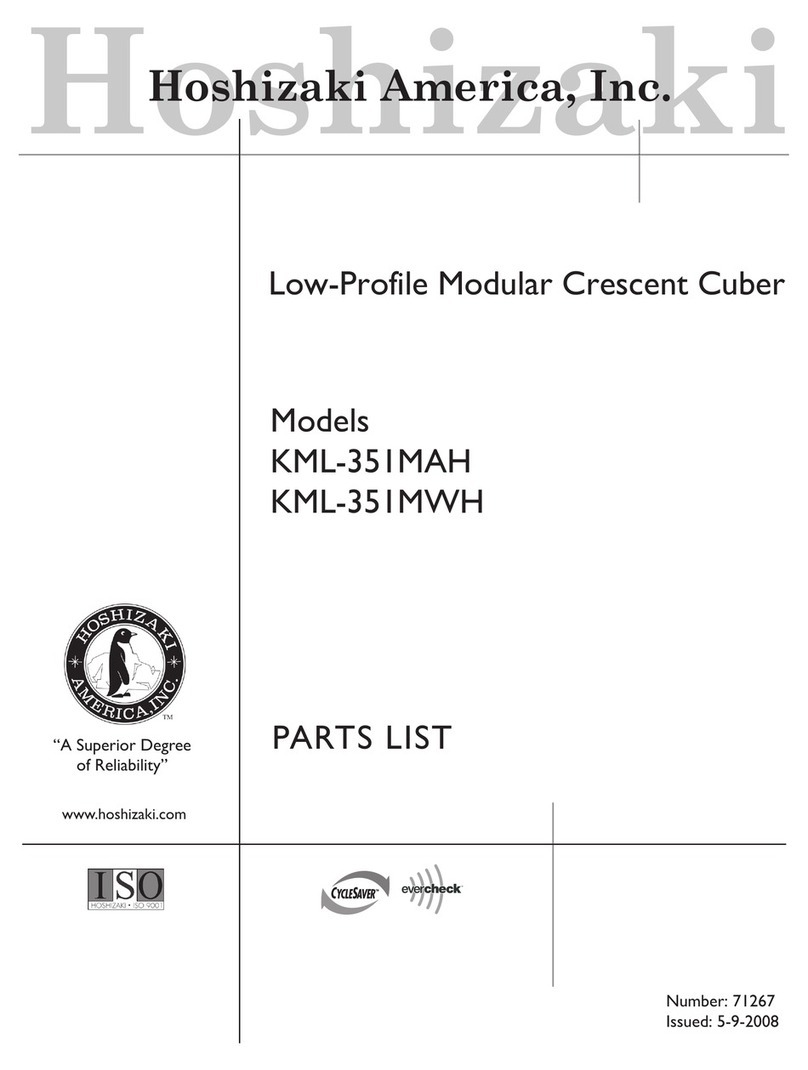
Hoshizaki
Hoshizaki KML-351MAH parts list
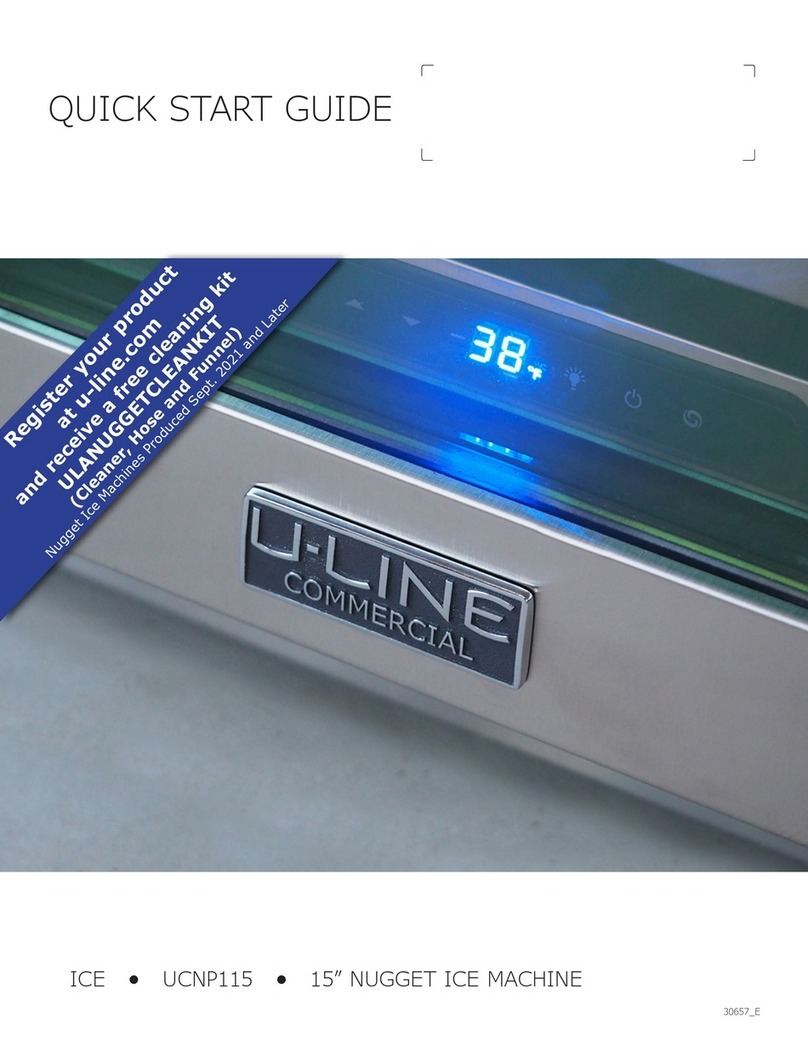
U-Line
U-Line UCNP115 quick start guide
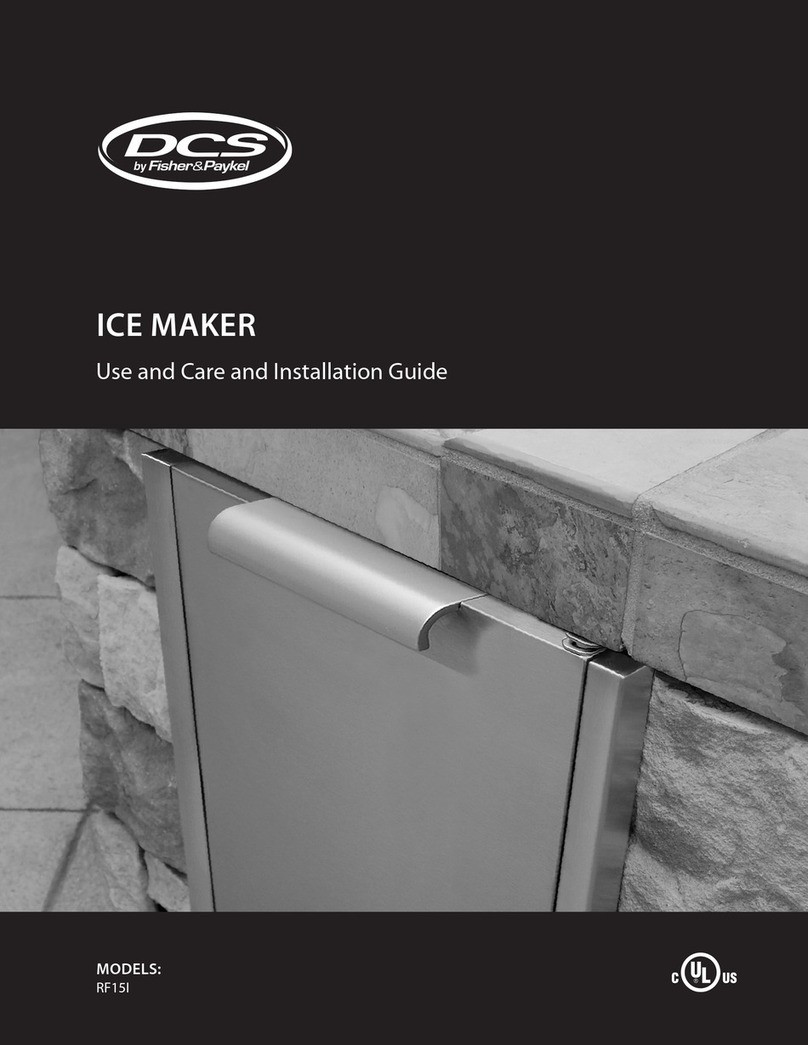
DCS
DCS RF15I Use and care and installation guide
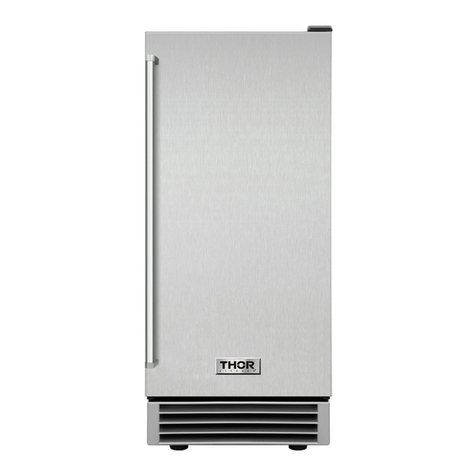
Thor Kitchen
Thor Kitchen HIM1555BLK Service manual
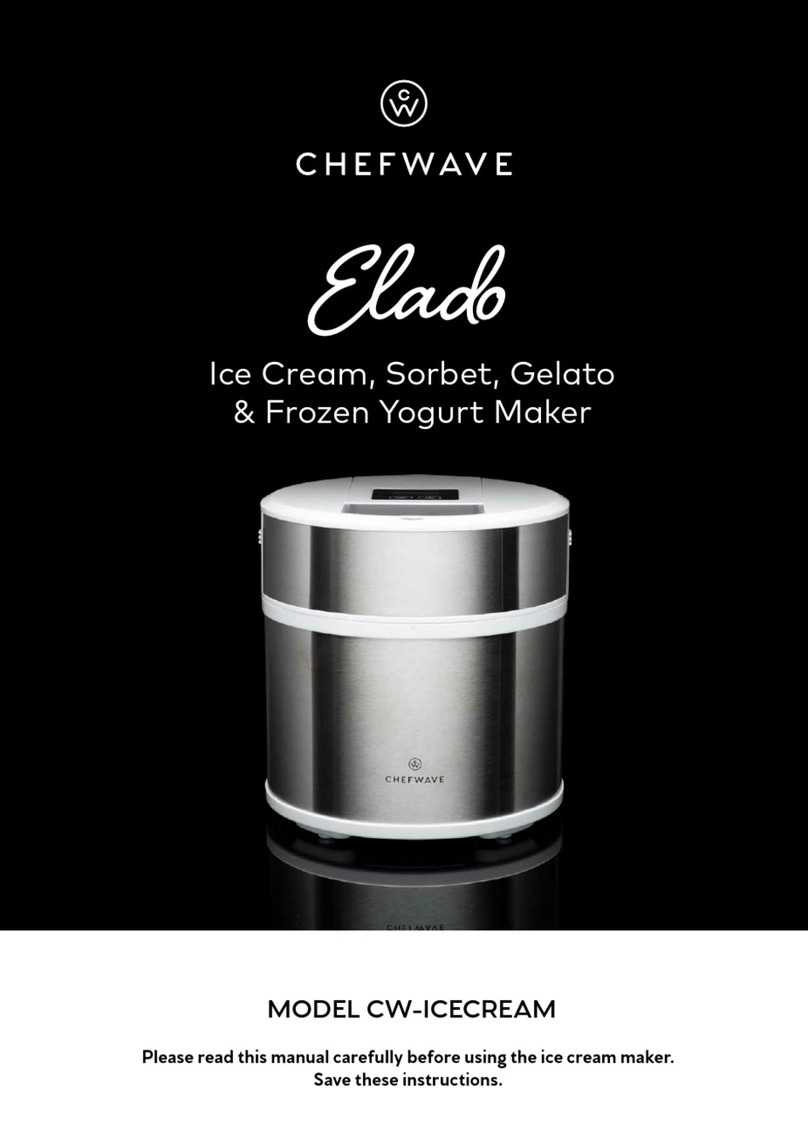
Chefwave
Chefwave CW-ICECREAM manual
